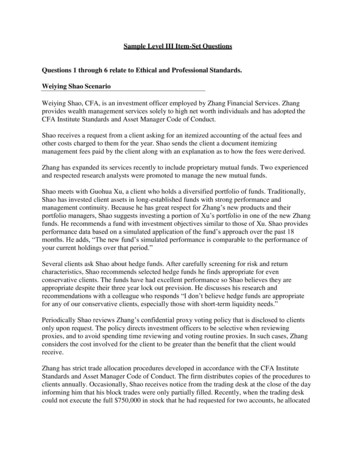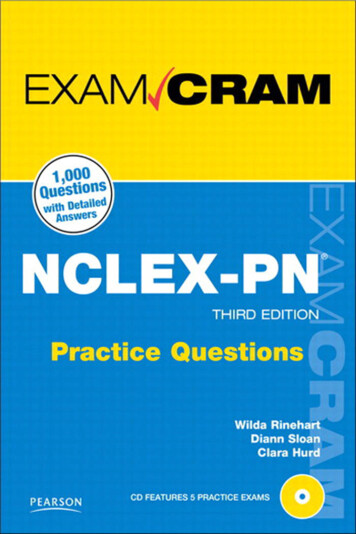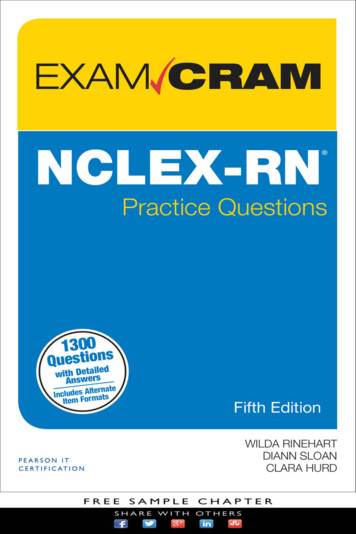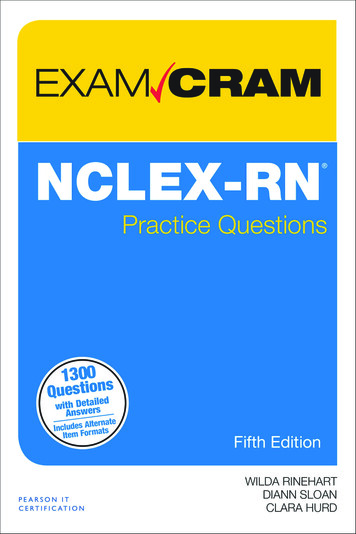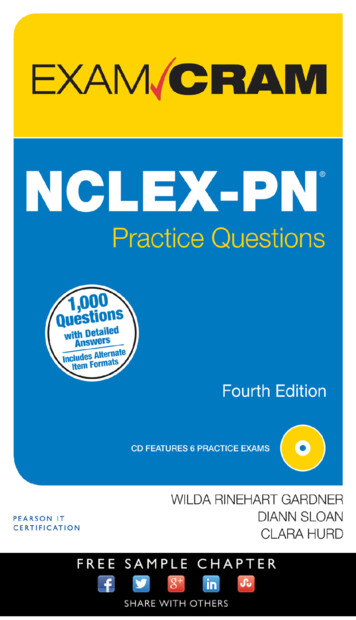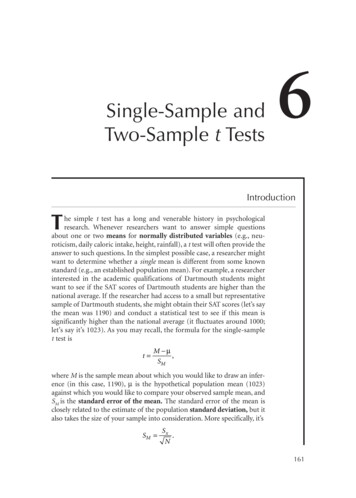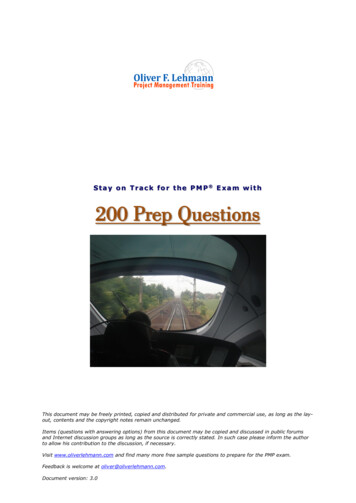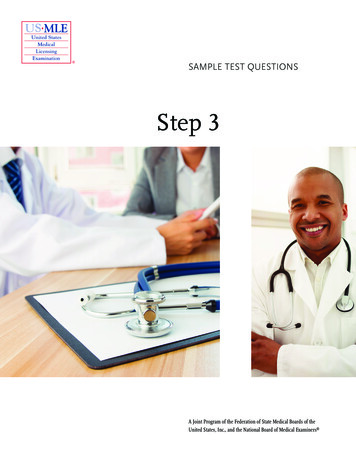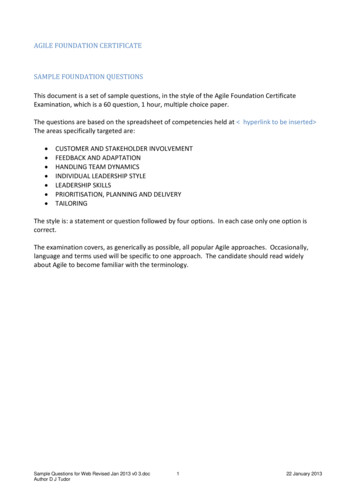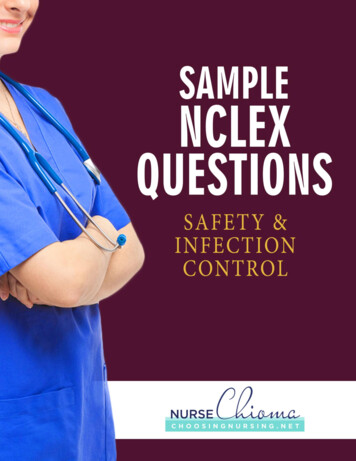
Transcription
SAMPLE NCLEX QUESTIONSWWW.CHOOSINGNURSING.NET1
1. A home health nurse is doing an admissions assessment, part of which includesthe risk for falls. Which of the following is the most important factor to considerwhen assessing this risk?a.b.c.d.2.Your patient had a complete hysterectomy yesterday. When you enter herroom, she is sitting on the side of the bed. Her skin is cold and pale; she doesnot respond to verbal stimulation and slowly responds to tactile stimulation.What is the first thing you should do?a.b.c.d.3.how often the patient is ambulatory inside his homewhether the patient experiences orthostatic hypotensionproper lighting in each room of the homeif the patient has been diagnosed with diabetes mellitusassess vital signscall for a crash cart because the patient appears to be near collapsehelp the patient back to bedadminister oxygen at 3L per nasal cannulaA 20 year old patient has been being treated for second and third-degreeburns over 30% of his body. Part of the discharge planning education includeswound care instructions. Which statement made by the patient would lead thenurse to feel that he is ready to be discharged and begin home care?a. “I need to keep my wound covered in the wound bandage 24 hrs a day.”b. “If any healed areas break open, I should cover them with a steriledressing and notify the doctor’s office right away.”c. “If I have a temperature, I can take Tylenol every 4 hours.”d. “I can take sponge baths, but not tub baths because tub baths haveunsterile water.”4.A nurse teaching health safety to new employees who work dietary, instructsthe new employees on the importance of proper handwashing after toileting toprevent:a.b.c.d.the spread of acquired immune deficiency syndrome (AIDS)the spread of hepatitis Cthe spread of leukemiathe spread of hepatitis ASAMPLE NCLEX QUESTIONSWWW.CHOOSINGNURSING.NET2
5.You are the charge nurse on your unit. Today you are evaluating the unit’sinfection control procedures. Which of the following indicates the need forfurther education of staff?a. The nurse aide is not wearing gloves when feeding an elderly client.b. A client with active tuberculosis is asked to wear a mask when he leaveshis room to go to another department for testing.c. A nurse’s aide with open lesions on her hands double gloves prior togiving direct client care.d. The nurse puts on a mask, a gown, and gloves before entering the room ofa client on strict isolation.6.A 5 year old patient is brought in to the emergency room with rashes foundmostly on his abdomen. The mother reports that the child has had a cough andsore throat and has displayed a decrease in appetite. Based on the symptomsreported, the nurse suspects that the child may have:a.b.c.d.7.You are the RN on the evening shift and are preparing to delegate care of aclient who is in upper extremity restraints to a nurse assistant on your team.Which of the following would you instruct the nurse assistant to report to youimmediately?a.b.c.d.8.pneumoniastrep throatchicken poxmeaslesThe patient insists she is hungry and wants a snackany signs of redness under the restraintthe patient cursing her because she does not want to have restraintsthe patient had two bowel movements during this shiftAs the hospital’s education nurse, you are responsible for educating staff onthe prevention of the transmission of HIV. Which of the following wouldindicate to you that the staff has a clear understanding of universalprecautions?a. a pregnant nurse states she cannot care for an HIV positive patient due tothe risk of the virus being transmitted to her unborn childSAMPLE NCLEX QUESTIONSWWW.CHOOSINGNURSING.NET3
b. nursing assistants change gloves between feeding patientsc. a nurse assistant dons personal protective equipment before assisting thecharge nurse who is suctioning a tracheostomyd. the lab supervisor wears gloves while recapping the needle after drawingblood from a patient9.When practicing transmission-based precautions, the nurse is correct to dowhich of the following:a. wear a mask when providing care for the patientb. use a disposable thermometer each time she checks the patient’stemperaturec. use biohazard bags with zip closures when sending specimens to the labd. instruct the patient’s visitors on the proper way to apply a face mask10. While receiving report as you are coming on to the evening shift, the nursegiving report notifies you that Mr. Jenkins, a new patient who will be in yourcare, has a recent history of seizure disorder. Which of the following is anappropriate action as his primary nurse?a. assign a nurse assistant to observe the patient during his evening meal toprevent chokingb. remove all pillows from the patient’s bed to prevent suffocation if hebegins to seizec. instruct all staff providing care to the patient to make sure the patient’sbed is kept in the lowest position at all timesd. move the call light away from the bed so that the patient does not gettangled in the cord if he begins to have a seizure11.Mr. Smith is being discharged from the hospital and will be required to changethe dressing on his injured leg daily. The dressing is to be sterile. Mr. Smith is toirrigate the wound with normal saline, pat dry with sterile 4 x 4s and applysterile 4 x 4s covered with an abdominal pad. Which statement by Mr. Smithindicates that he requires further instruction regarding the proper technique forhis wound care?a. If I am unsure whether any of the material is sterile, I should discard it at once.b. I need to put on my sterile gloves and then open the normal saline andpour it onto the 4 x 4s to soak them.SAMPLE NCLEX QUESTIONSWWW.CHOOSINGNURSING.NET4
c. If a 4 x 4 appears soiled, I should throw it away, even if I just took it out ofthe sterile package.d. I should check the expiration date of all products used to do my wound care.12. With regard to patient safety, which is the most appropriateassessment/instruction for the nurse to perform following a myelogram?a. check for bilateral popliteal bruisingb. remind the patient that lying on his right side is restricted until thephysician clears himc. assess for proper neurological functiond. keep the patient’s feet elevated for the first two hours following theprocedure13. When educating a new LPN on safety measures regarding a patient withhemiplegia, the following statement indicates that the nurse requires furtherinstruction:a. “Paralysis can be frustrating, and I will be sure to encourage any effort mypatient makes in attempting independent care.”b. “Difficulty swallowing is common with patients with hemiplegia.”c. “Passive range of motion is very important in helping decrease muscleatrophy in a paralyzed patient.”d. “When helping my patient reposition in the bed, I need to place my handunder the affected arm for assistance.”14. A patient is ordered to have a CT scan with contrast. What is the first step thenurse should take to ensure patient safety?a.b.c.d.encourage fluids after the procedureobtain a copy of the patient’s power of attorneycheck the patient’s chart for allergieskeep the patient’s call light within reach at all timesSAMPLE NCLEX QUESTIONSWWW.CHOOSINGNURSING.NET5
15. A bladder scan on your patient who has reported inability to void revealsapproximately 2000mL of urine in the bladder. The nurse understands thatwhich of the following is important when preparing to perform catheterization?a. allow the patient to attempt to void after 300 mL of urine has been drainedb. instruct the patient on the importance of proper hydrationc. teach the patient’s spouse how to perform catheterization in the event thishappens againd. clamp the catheter tubing after each 500 mL is drained and wait fiveminutes before opening the clamp againAnswers:1.C: Proper lighting is essential in the prevention of falls, especially in the elderlywho may already experience impaired vision.2.C: Help the patient back to bed. AFTER the patient is assisted back to bed,oxygen at 2L per minute can be initiated and vital signs checked.3.B: If any healed area opens again, the doctor should be immediately notified.The patient should report fever immediately, as this could be a sign of infectionand he should be assessed. Administering Tylenol every 4 hours may relievethe fever, but not resolve the cause of the fever.4.D: Hepatitis A is transmitted through contaminated food or water, often by thehands of infected people who do not practice good handwashing aftertoileting.5.C: Healthcare workers with open wounds or lesions should not provide directcare to patients until the wounds are completely healed.SAMPLE NCLEX QUESTIONSWWW.CHOOSINGNURSING.NET6
6.C: Chickenpox (varicella) often presents with a low-grade temperature,decreased appetite, cough and sore throat prior to the breakout of blisters onthe skin. With the history provided by the mother regarding the previous days,the symptoms are indicative of the chickenpox virus.7.B: Any redness under the restraints should be reported immediately as thismay indicate that the restraints have been applied too tightly which could leadto compromised circulation of the affected area.8.C: HIV is transmitted by exposure to blood or body fluids. The application ofpersonal protective equipment prior to any procedure during which exposure ispossible helps reduce the risk of spread of the virus.9.C: When lab specimens are placed in appropriate containers and thentransported in biohazard bags with zip closures, it reduces the risk of exposureto infectious disease.10. C: Keeping the patient’s bed in the lowest position prevents the risk of injury byfalls related to seizures.11.B: Mr. Smith does not need to put on sterile gloves before opening the normalsaline. The normal saline cap is not sterile; therefore, if he puts the sterilegloves on prior to opening the bottle, he will contaminate his gloves.12. C: Assess for appropriate neurological response13. D: Placing an arm under the affected shoulder could cause displacement, espsince the patient is unable to feel and report any pain or discomfort. A drawsheet should be used to turn or reposition the patient.14. C: Although encouraging fluids to flush the kidneys is important; checking thepatient’s charts for allergies is the first priority.15. D: Clamping the tubing after every 500 mL and waiting five minutes allows thebladder to “rest” and thus helps to prevent bladder spasms.SAMPLE NCLEX QUESTIONSWWW.CHOOSINGNURSING.NET7
Want more NCLEX Questions?Sign up for our Free NCLEX Predictor Test!GET STARTED NOWSAMPLE NCLEX QUESTIONSWWW.CHOOSINGNURSING.NET8
c. the spread of leukemia d. the spread of hepatitis A . SAMPLE NCLEX QUESTIONS WWW.CHOOSINGNURSING.NET 3 5. You are the charge nurse on your unit. Today you are evaluating the unit’s infection control procedures. Which of the following indicates the need for further education of staff? a. The nurse aide is not wearing gloves when feeding an elderly client. b. A client with active .

